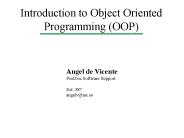Introduction to Object-Oriented Programming - PowerPoint PPT Presentation
1 / 19
Title:
Introduction to Object-Oriented Programming
Description:
Class Diagram. Fields. of. the. Class. Interface. method. method. method. method. method. method. method ... classes within the set of attributes or behaviours ... – PowerPoint PPT presentation
Number of Views:19
Avg rating:3.0/5.0
Title: Introduction to Object-Oriented Programming
1
Introduction to Object-Oriented Programming
- Sandy GrahamUniversity of Waterloofor
theImperial Oil Summer Institutefor Computer
Studies Teachers - August 2003
2
What is O-O?
- Design, programming, and languages
- An alternative to procedural programming
- anything done using O-O can also be done using a
procedural paradigm - Considering a problem from the perspective of
objects and how they interact
3
Skills for O-O Programming
- Must have a solid understanding of subprograms
and parameters - stepwise refinement
- Should understand references/pointers
- Coding still involves basic concepts
- selection structures, repetition structures,
4
O-O vs. Procedural
- Procedural Paradigm
- Program defines data and then calls subprogram to
act on the data - Object Paradigm
- Program creates objects that encapsulate the data
and procedures that operate on the data
5
Basic Concepts
- Objects
- Hidden data that is accessed and manipulated
through a well-defined interface - Classes
- A template or blueprint for creating objects,
each with their own data - Inheritance
- A new class created by modification of an
existing class
6
Objects
- Part of a program which
- models some real or conceptual object
- has behavioural responsibilities (behaviours)
- has informational responsibilities (attributes)
- Behaviours (methods)
- things an object can do
- like procedures and functions in other languages
- Attributes (fields)
- information an object knows (has-a)
- like data and variables in other languages
(records)
7
Classes
- A class is a template. No data is allocated until
an object is created from the class. However
attributes and behaviours are generically defined - The creation (construction) of an object is
called instantiation. The created object is often
called an instance (or an instance of class X)
8
Analogies for Classes Objects
- Class
- blueprint
- pattern
- cookie cutter
- factory
- Object
- building
- garment
- cookie
- widget
Platos allegory of the cave.
9
Class Diagram
Internal/private/helper methods only available
within the class.
Defined by the class. Filled by the object.
10
Encapsulation - Real Life
- Bank machine
- Hidden data
- account balance
- personal information
- Interface
- deposit, withdraw, transfer
- display account information
11
Multiple Instances of a Class
- No limit to the number of objects that can be
created from a class - Each object is independent. Changing one object
doesnt change the others
12
Interaction Among Classes
- A program is composed of multiple classes
- Classes may contain references to other classes
within the set of attributes or behaviours - Start in an application class (main)
- construct one or more objects and call methods
associated with those objects
13
Using UML in Design
Bank
- every class has a box
- class name
- attributes/instance variables
- behaviours/methods
- Arrows indicate the relationships among classes
- indicates 0-many
1
14
Inheritance
- The inheriting class contains all the attributes
and behaviours of the class it inherited from
plus any attributes and behaviours it defines - The inheriting class can override the definition
of existing methods by providing its own
implementation - The code of the inheriting class consists only of
the changes and additions to the base class
15
Inheritance Diagram
General Outline
16
Why Use Inheritance?
- Modular coding
- less code, easier to understand
- Code reuse
- dont break what is already working
- easier updates
- May not have access to modify the original source
code - Polymorphism
17
Inheritance Terminology
- Class one above
- Parent class, Super class
- Class one below
- Child class
- Class one or more above
- Ancestor class, Base class
- Class one or more below
- Descendent class
18
Inheritance Bank Account
19
Basic Concepts
- Objects
- Hidden data that is accessed and manipulated
through a well-defined interface - Classes
- A template or blueprint for creating objects,
each with their own data - Inheritance
- A new class created by modification of an
existing class































